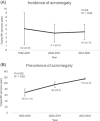The prevalence of acromegaly is higher than previously reported: Changes over a three-decade period
- PMID: 36163677
- PMCID: PMC9827885
- DOI: 10.1111/cen.14828
The prevalence of acromegaly is higher than previously reported: Changes over a three-decade period
Abstract
Objective: To study time-related changes in the prevalence and patient characteristics of acromegaly, as well as to assess the impact of changes in treatment on disease control.
Methods: A total of 107 patients with acromegaly were identified by healthcare registries and subsequently validated by patient chart review over a three-decade period (1992-2021). A systematic literature review focusing on the incidence and prevalence of acromegaly was performed identifying 31 studies.
Results: The prevalence of acromegaly significantly increased throughout the study period (R2 = 0.94, p < .001) and was 122 cases/106 persons in 2021 whereas the annual incidence remained constant at 4.6 cases/106 persons. The age at the first sign of acromegaly and the age at diagnosis significantly increased during the study period, whereas growth hormone and insulin-like growth factor I decreased. Incidentalomas constituted 32% of all cases diagnosed with acromegaly in the last decade. Primary surgery was used in 93% of all cases, and repeated surgery decreased from 24% to 10% during the three decades. The use of first-generation somatostatin analogues (21%-48%) and second-line medical treatment (4%-20%) increased with a concomitant improvement of biochemical disease control (58%-91%).
Conclusion: The prevalence of acromegaly is higher than previously reported and the clinical presentation has shifted towards a milder phenotype. Modern treatment of acromegaly enables individualized treatment and disease control in the majority of patients.
Keywords: acromegaly; growth hormone; pituitary adenoma; pituitary endocrinology.
© 2022 The Authors. Clinical Endocrinology published by John Wiley & Sons Ltd.
Conflict of interest statement
P. V. unrestricted research grant from IPSEN. J. D. unrestricted research grant from Pfizer and IPSEN. The study was supported by unrestricted research grant from Pfizer and IPSEN.
Figures



References
Publication types
MeSH terms
Substances
LinkOut - more resources
Full Text Sources

